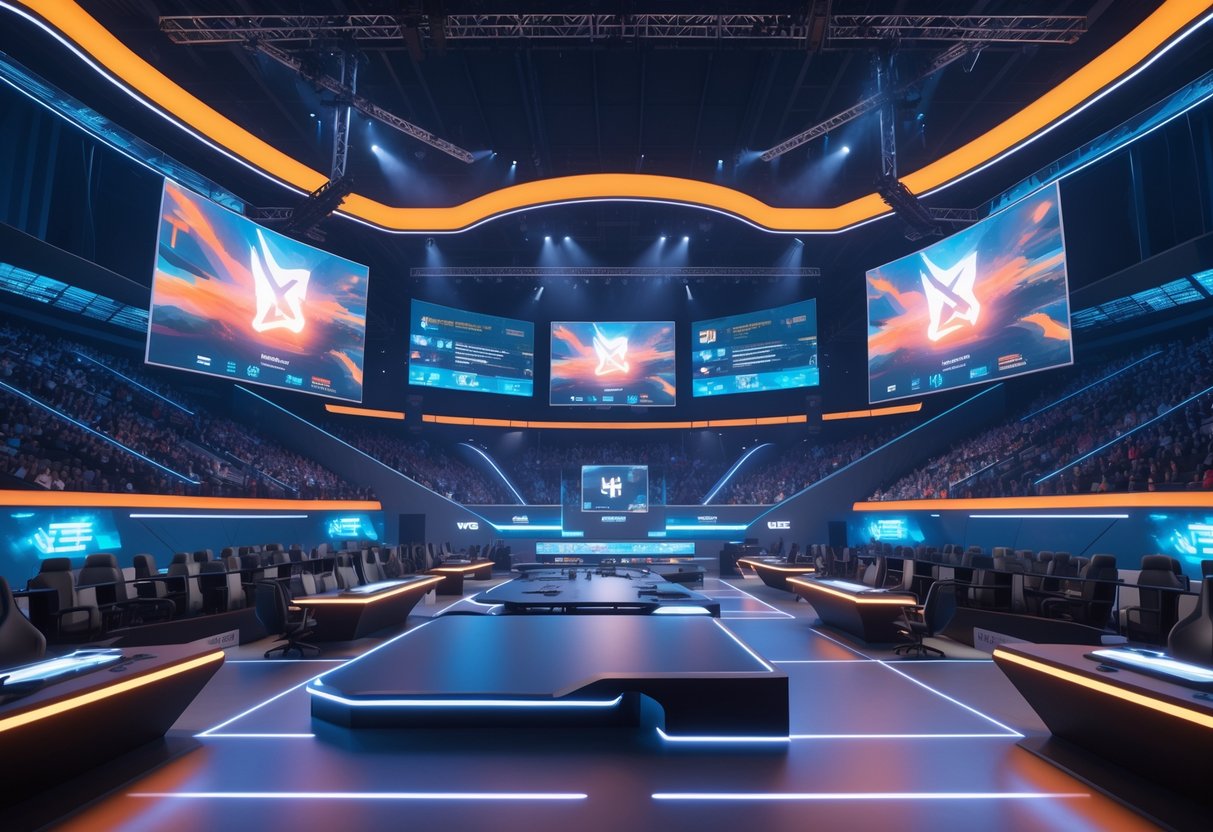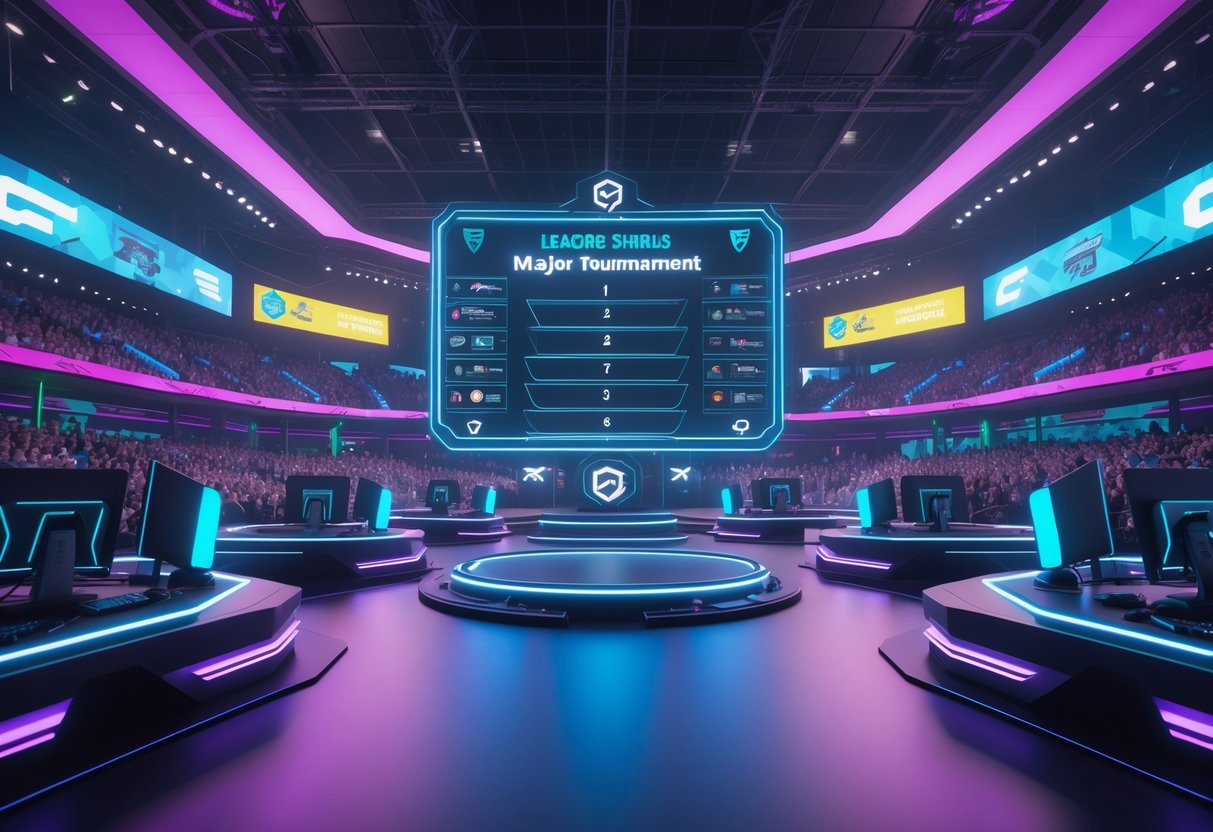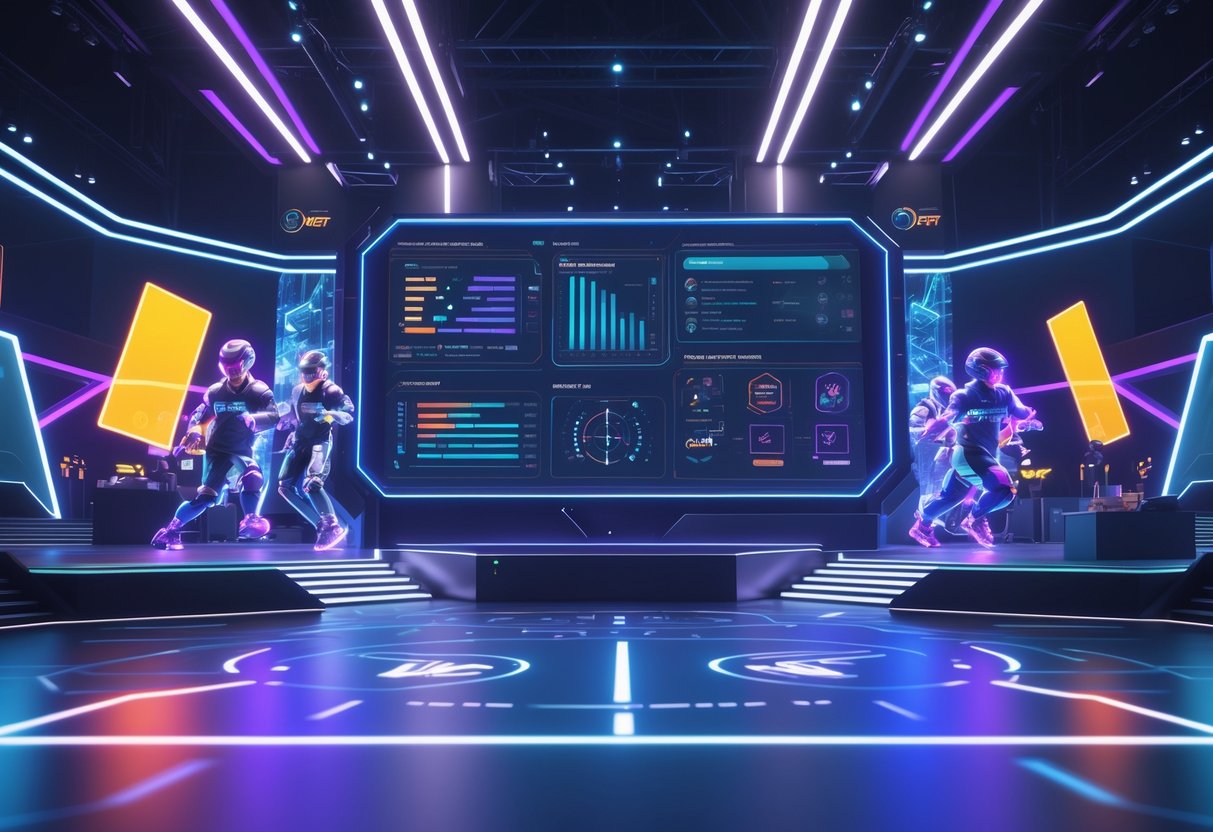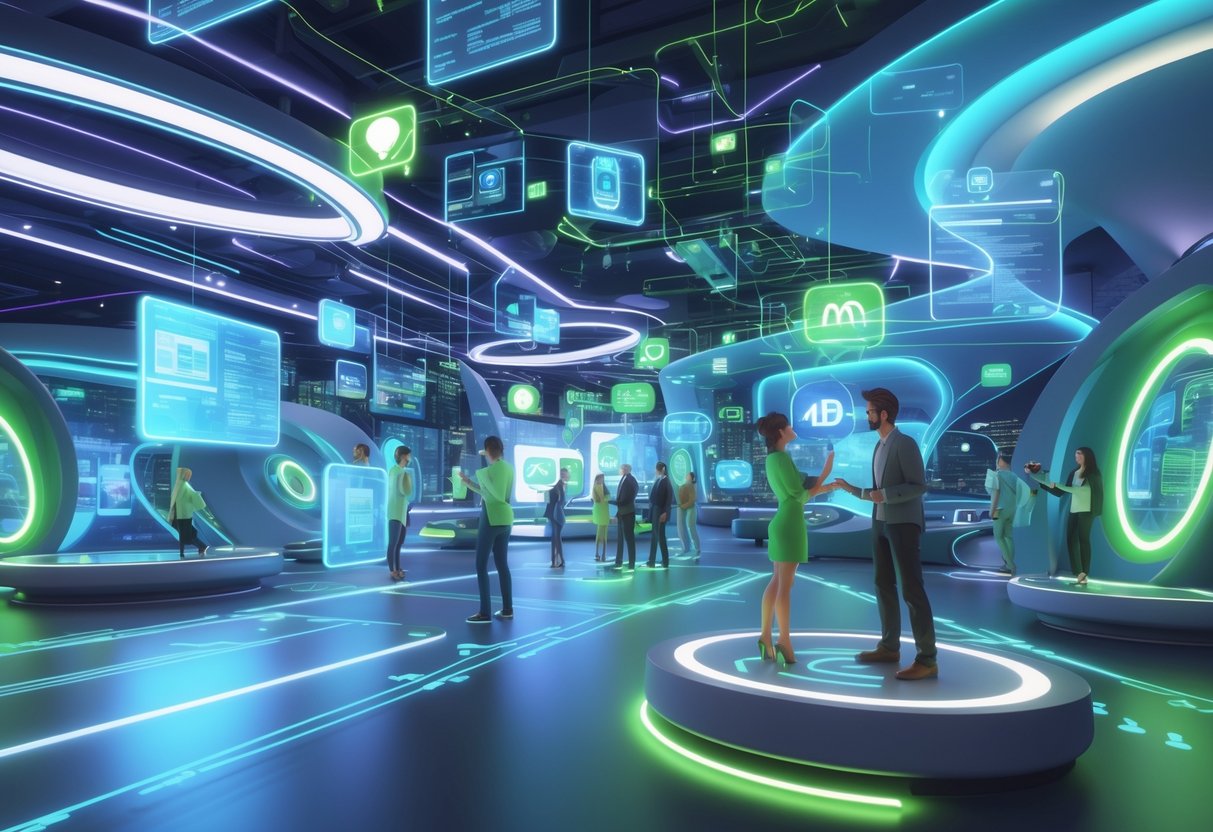CS2 Major Changes 2025: All the Essential Format Updates
Updated On: August 23, 2025 by Aaron Connolly
Expansion of CS2 Majors Format
Counter-Strike 2 Majors are getting a lot bigger in 2025. The tournament jumps from 24 to 32 teams, and there’s an extra Swiss stage now.
On top of that, the event stretches out about four more days than before. That’s a pretty big shake-up.
Increase in Participating Teams
Valve confirmed that CS2 Majors will feature 32 teams starting in 2025. The BLAST.tv Austin Major is set to be the first with this expanded setup.
That’s the biggest change to the CS2 Major format in six years, honestly. Adding eight more teams means more regional representation and, hopefully, a few new faces breaking through.
The expansion changes how teams qualify for each stage. More spots open up through the new Major Regional Qualifiers (MRQ), which take over from the RMR system.
European teams, in particular, get a boost here. Sixteen European squads compete in MRQ events, while the Americas get sixteen, and Asia gets eight. Europe’s dominance in recent tournaments probably explains that.
Addition of Third Legends Swiss Stage
The CS2 Major format now features three Swiss stages instead of two. So, we get Opening, Elimination, and then a third stage to fit the bigger roster.
This third Swiss stage gives teams a more balanced progression. Eight teams that qualify from Stage 1 join eight directly invited rosters in Stage 2, then move on to Stage 3.
Valve hands out direct invites based on regional performance from the last Major. For Austin 2025, Europe gets six Stage 3 invites since six of their teams made the playoffs in Shanghai.
Americas and Asia each get one Stage 3 invite, reflecting their playoff appearances at the last Major. That’s supposed to keep competitive balance in check, at least in theory.
Extension of Tournament Duration
CS2 Majors now run about four days longer than before. The extra time covers the new Swiss stage and the flood of new teams.
This longer schedule gives teams a breather between matches. It should help with fatigue and give everyone more prep time.
Organisers get more content to work with and more chances to show off sponsors. More days mean more broadcast hours and, hopefully, more fans tuning in.
Viewers can expect a ton more matches, especially with the Swiss system tossing up all sorts of elimination scenarios. The extra days also help with scheduling across time zones—always a headache otherwise.
Introduction of Major Regional Qualifiers (MRQ)
Valve rolled out Major Regional Qualifiers (MRQ) in 2025, replacing the old Regional Major Rankings system. These qualifiers bring different team counts across regions and, for the first time, let teams compete online for a CS2 major spot.
MRQ Structure and Regions
The MRQ system splits qualifying teams into three main regions, each with its own allocation. Europe gets 16 qualifying spots, which makes sense given their massive player base and tournament infrastructure.
Americas also land 16 spots for MRQ events. That covers North America, South America, and some other territories.
Asia gets a smaller 8-team MRQ format. The CS2 scene there is still growing compared to Europe and the Americas.
Each regional MRQ feeds straight into Stage 1 of the new 32-team major format. Teams have to qualify through their region, based on roster and location.
Perfect World continues to run Asian region qualifiers. They handle logistics and make sure teams stick to regional rules.
Online Qualifying Events
MRQs now allow major qualifying events to happen entirely online. The old RMR events forced everyone to show up on LAN, which meant higher costs and travel headaches.
The online format slashes operational costs. Teams don’t need to worry about flights, hotels, or visas just to qualify.
Valve originally scheduled MRQs for October 16-19 for the Budapest Major. But those dates clashed with other big tournaments like CS Asia Championships and Thunderpick World Championship.
Online play does bring some new headaches. Tournament integrity relies even more on anti-cheat and stable connections.
Some pros have voiced concerns about online qualifiers and fairness. LAN just feels more legit for a lot of players.
Slot Allocation by Region
The BLAST.tv Austin Major set the baseline slot distribution for all regions. Teams get different starting positions based on their Valve Regional Standings performance.
| Region | Stage 3 Direct | Stage 2 Entry | MRQ Slots Available |
|---|---|---|---|
| Europe | 6 teams (1st-6th VRS) | 4 teams (7th-10th VRS) | 6 slots (11th-26th compete) |
| Americas | 1 team (1st VRS) | 4 teams (2nd-5th VRS) | 6 slots |
| Asia | 0 direct | 2 teams | 4 slots |
Europe gets the biggest slice, thanks to its deep pool of top teams year after year.
Americas mostly has to fight through MRQs, with just one direct Stage 3 spot. Most teams there have to earn their place the hard way.
Asia’s path is even tougher. Only 4 MRQ slots are up for grabs, so competition gets pretty fierce.
Changes to the Qualification System

The CS2 Major qualification system just got its biggest overhaul since 2018. Teams now have to qualify through a new structure that ditches the old Regional Major Ranking system for direct invitations based on Valve’s rankings.
Replacement of Regional Major Ranking (RMR)
Valve decided to scrap the Regional Major Ranking (RMR) events for 2025. Previously, teams earned points at these tournaments to qualify for Majors.
Now, Valve brings in Major Regional Qualifiers (MRQs) as the only route to reach the Major’s first stage.
Here’s what’s different:
- Online formats allowed for the first time
- Regional splits (like North America/South America) are possible
- All invites based on VRS rankings instead of RMR points
- Best-of-three matches for smaller regions like Asia
| Region | MRQ Teams | Stage 1 Spots |
|---|---|---|
| Europe | 16 | 6 |
| Americas | 16 | 6 |
| Asia | 8 | 4 |
Only 16 teams qualify through MRQs. The other 16 Major spots go to direct invites.
Direct Invitations and Previous Major Performance
Valve’s VRS (Valve Ranking System) now decides most Major participants directly. That’s a huge shift from the grind-heavy approach of the past.
16 teams get direct invitations to Stage 2 and Stage 3. Valve hands out these spots based on:
- Current VRS standings
- Recent tournament results
- Regional representation rules
Top teams bypass MRQs completely. That sets up a clear pecking order—established teams get in automatically, while up-and-comers need to run the qualifier gauntlet.
Europe takes the lion’s share with 10 direct invites. The Americas get 5, and Asia gets just 1.
This system rewards teams that perform well all year, not just in one lucky run. If you want to skip qualifiers, you’ve got to keep your VRS up.
Key CS2 Majors of 2025
The 2025 CS2 Major season brings two confirmed tournaments with the new 32-team format. The BLAST.tv Austin Major kicks things off in June, and then the Perfect World Shanghai Major follows later in the year.
BLAST.tv Austin Major
The BLAST.tv Austin Major launches CS2’s new 32-team format. This June event in Texas is the first to show off the three-stage Swiss system.
Sixteen teams make it through the Major Regional Qualifiers (MRQs). The other 16 spots go to teams that Valve invites based on their new rankings.
Key Format Changes:
- Stage 1: 16 teams (MRQ qualifiers)
- Stage 2: 8 teams (direct invites)
- Stage 3: 8 teams (direct invites)
The tournament ditches the old RMR system for MRQs. Qualifiers can now run online and might even split North America and South America.
Austin is a big step for CS2. More teams means more prize money and sticker revenue to share around, which could really help Tier 2 teams everywhere.
Perfect World Shanghai Major
Perfect World hosts the second Major of 2025 in Shanghai. This one sticks with the 32-team format from Austin.
Shanghai benefits from Asia’s growing CS2 scene. The region has dedicated MRQ spots, though fewer than Europe and the Americas.
Asian Qualification Structure:
- Next 8 teams from VRS rankings
- 4 Stage 1 spots available
- 1 Stage 3 direct invite slot
Perfect World knows how to run big esports events, so Shanghai looks like a solid pick. The timing should work well for Asian viewers and still pull in a global audience.
We’ll probably see more Asian teams in the spotlight here. The expanded format gives them a better shot against established European and American squads.
Budapest Major Rumours
Word is, Budapest might host a third Major in 2025. Valve hasn’t confirmed anything yet, though.
If it happens, Budapest would bring CS2 back to Central Europe. The city boasts strong esports infrastructure and a lively Counter-Strike community.
Potential Timeline:
- Spring: Austin Major (confirmed)
- Summer: Shanghai Major (confirmed)
- Autumn/Winter: Budapest Major (rumoured)
A December Major would wrap up the 2025 season. That lines up with the usual pattern—two confirmed Majors and maybe room for more.
We’re keeping an eye out for official word from Valve on Budapest. The success of the 32-team format in Austin and Shanghai will probably influence any extra Majors next year.
Adjustment in Tournament Scheduling

Valve has overhauled the CS2 Majors calendar for 2025. Now there are two events per year on a fixed schedule, instead of the old unpredictable system.
Primary Event Dates
The 2025 CS2 Majors run on a set bi-annual schedule. Valve picked 9-22 June and 1-14 December for this year.
That’s a big change from the old days of random dates. Organisers can finally plan ahead.
The BLAST.tv Austin Major starts things off on 9 June 2025, with 32 teams battling it out.
Looking to 2026, the dates are 8-21 June and 30 November-13 December.
Each Major now lasts exactly two weeks. Teams get more time to adjust during the expanded Swiss stages.
The December slot lands right in the holiday esports season. That’s usually when fans have the most time to tune in.
Introduction of Additional Prestigious Tournaments
Valve sees that just two Majors a year leave some pretty big gaps in the competitive calendar. So, they’re rolling out more top-level tournaments to fill those quiet stretches.
The company wants to keep the momentum going all year. More big events mean top teams stay active between Majors.
These extra tournaments will probably offer large prize pools. That’s how they’ll keep attracting the best CS2 teams, time after time.
Perfect World and other major organizers plan to host these events. They’ll aim for production standards similar to the official Majors.
With a more crowded calendar, up-and-coming teams get more chances to break through. More consistent high-level play helps local talent develop too.
Regional qualifiers will pop up more often. Teams won’t have to wait ages for another shot at qualifying for something big.
Tournament Stage Breakdown

CS2 Majors now run on a three-stage Swiss system with 32 teams fighting through Opening Stage, Stage 2, and Stage 3. Teams move forward based on match wins, and their starting point depends on their VRS (Valve Regional Standing) rank.
Opening Stage Details
The Opening Stage brings in 16 teams who earn their spot through Major Regional Qualifiers (MRQs). These squads start off at the bottom rung of the Major.
Teams play Swiss format matches until they rack up either 3 wins or 3 losses. The first round of matches is best-of-one, but elimination and advancement rounds switch to best-of-three.
Opening Stage breakdown:
- Europe MRQ: 6 spots
- Americas MRQ: 6 spots
- Asia MRQ: 4 spots
Teams that snag 3 wins before 3 losses move to Stage 2. If a team loses 3 times first, they’re out of the Major.
The Opening Stage usually wraps up in 3-4 days. Every match uses the Buchholz seeding system to pair teams with similar records.
Progression to Stage 2 and 3
Stage 2 has 8 teams. The group includes the Opening Stage winners, plus teams who get direct invites based on VRS rankings.
Stage 2 composition:
- 8 from Opening Stage
- 8 with direct VRS invites
Stage 2 sticks with the same Swiss format as before. Teams need 3 wins to move on or get eliminated after 3 losses.
Stage 3 throws in 8 more direct VRS invitees and the Stage 2 winners. That sets up the final 16 teams for the playoff bracket.
This system rewards consistency throughout the year but still gives MRQ teams a real shot at the championship.
Legends and Playoffs Structure
Stage 3 is the “Legends Stage” with 16 top teams. You get 8 from Stage 2 and 8 more based on VRS rankings.
The Legends Stage uses the Swiss system to sort out playoff seeding. Teams play until they reach 3 wins or 3 losses.
Playoff structure:
- Top 8 from Legends Stage qualify
- Single-elimination bracket
- All matches are best-of-three
- Grand final could be best-of-five
The playoff bracket seeds teams 1-8 based on Legends Stage results. Higher seeds face lower seeds, just like most tournaments.
This format keeps things fair and lets more teams earn Major sticker money and get seen on the world stage.
Impact on Teams and Regional Representation

Expanding to 32 teams draws clearer regional lines and opens doors for squads outside the usual big names. Europe gets the most slots, but Asia and the Americas see their numbers shift based on how strong their scenes are.
Distribution of Teams by Continent
Europe leads with 16 total slots. That’s 6 from MRQs, 4 from Stage 2, and 6 direct invites for Stage 3.
The Americas land 11 total slots, split between North and South America. North America grabs 6 MRQ spots and 4 Stage 2 places, while South America gets 1 in Stage 3.
Asia ends up with 5 positions. Teams there qualify through 4 MRQ spots and 1 Stage 3 invite based on VRS.
| Region | MRQ Slots | Stage 2 | Stage 3 | Total |
|---|---|---|---|---|
| Europe | 6 | 4 | 6 | 16 |
| North America | 6 | 4 | 0 | 10 |
| South America | 0 | 0 | 1 | 1 |
| Asia | 4 | 0 | 1 | 5 |
Multi-region teams now have to play in their strongest region. So, a team like Liquid represents Europe instead of picking between regions.
Opportunities for Emerging Teams
The MRQ system opens up 40 qualifying spots across all regions. Before this, the old 24-team setup made it tough for emerging teams to break in.
Tier 2 teams get a boost from more Major sticker revenue. Eight extra teams can now earn a cut, which might help their financial stability.
Heads up: MRQ events could run online, which cuts down travel costs for teams trying to qualify. But in smaller regions, every match is Bo3, so teams have to prep even harder.
Regional splits let North and South America run their own MRQs, making qualification clearer for new teams.
CS2 Majors now use only VRS rankings for Stage 2 and 3 invites. Teams have to perform well across several tournaments, not just peak for a single qualifier.
Open qualifiers are gone, so new teams need VRS points to reach MRQs. That means the pathway is more structured, but you have to stay active and keep competing.
Notable Winners and Teams

Team Vitality crushed the first half of 2025 with a wild six-tournament win streak. Team Spirit showed up as their main rival in the second half. Roster shakeups and new Major formats have totally reshaped the scene.
Natus Vincere and Recent Champions
Team Vitality became the team to beat in CS2 during 2025. Fans saw them win IEM Katowice, ESL Pro League Season 21, BLAST Open Lisbon, IEM Melbourne, BLAST Rivals Spring, IEM Dallas, and the BLAST.tv Austin Major.
Their 30-win streak had the CS2 community buzzing. ZywOo kept delivering, grabbing five HLTV MVPs in a row during their hot streak.
Team Spirit emerged as Vitality’s main challenger. The Russian squad kicked things off with a BLAST Bounty Season 1 win, building on their Perfect World Shanghai Major title from late 2024.
Donk turned heads all year with his rifling. He helped Spirit snag more trophies, including PGL Astana and IEM Cologne.
| Team | Tournament Wins | Notable Achievement |
|---|---|---|
| Team Vitality | 7 | 30-match win streak |
| Team Spirit | 4 | Beat Vitality’s streak |
| MOUZ | 1 | First LAN win since 2024 |
| Team Falcons | 1 | Major roster changes |
Historic Performances in 2025
The Austin Major was a big deal for Team Vitality. Even though Legacy broke their streak, Vitality came back and took their second Major of the CS2 era. ZywOo bagged another Major MVP with another standout run.
Team Spirit’s comeback in late 2025 was something else. After starting strong, they came back even better at IEM Cologne and BLAST Bounty Season 2, finally ending Vitality’s reign.
MOUZ pulled off one of the year’s biggest upsets at PGL Cluj-Napoca. They came in ranked sixth in the Valve Regional Standings, but knocked out higher-seeded teams to win their first LAN since May 2024.
Rosters shifted all year. Ilya ‘m0NESY’ Osipov switched to Team Falcons from G2 Esports, and Emil ‘Magisk’ Reif played his last games before stepping away from competition.
These moves shook up the pecking order. Teams like Team Falcons made big changes to challenge the top dogs. The back half of 2025 proved even the most dominant teams can’t relax—there’s always someone ready to take their spot.
Market Changes: Stickers and In-Game Items
The CS2 skin market went through wild swings in 2025. Sticker values jumped around major events, and new cosmetic updates changed how players collect. Big tournaments sent sticker prices soaring, and Valve kept things fresh with new cosmetic systems.
Major Stickers and Capsules
Tournament stickers turned into a huge profit engine this year. The Austin Major in June sent event-specific sticker capsule demand through the roof.
Prices usually climbed 20-30% before tournaments as fans rushed to support their favourite teams. After the events, limited-edition capsules jumped 40-60% as supplies dried up.
The Budapest Major followed a similar pattern. Investors zeroed in on these cycles for their main profit plays.
Hot investment targets included:
- Team autograph stickers
- Holographic tournament logos
- Player signature capsules
- Championship trophy stickers
Sticker placement started to matter a lot for value. Skins with stickers in prime spots sold for two or three times more than poorly placed ones.
Traders often bought capsules during events, then held them for a few months. That approach paid off for collectors who wanted steady returns.
Operation Riptide and Cosmetic Updates
Valve shook up cosmetics all through 2025. The Armory Pass update especially sparked a market revival on trading sites.
New charm systems and agent skins gave collectors more to chase. These additions went beyond weapon skins and let players customize their characters even more.
Notable cosmetic additions:
- Weapon charms and keychains
- Updated agent models
- Improved sticker application
- New cases with premium finishes
The August 14th update brought big visual upgrades to maps and items. Skins looked better, and some float values changed.
Operation Riptide items stayed in demand all year. Rare drops from the operation’s case system turned into solid long-term holds for collectors.
A lot of traders started focusing on these new categories, since they weren’t as crowded as the usual weapon skin market.
CS2 Majors Format Innovations

The new 32-team CS2 Majors run on a three-stage Swiss system, replacing the old two-stage setup. Teams now fight through longer qualification paths via Major Regional Qualifiers instead of the RMR system.
Swiss System Implementation
The expanded Majors format uses three Swiss stages instead of two. So, you get 16 teams in Stage 1, 8 in Stage 2, and 8 more in the final Stage 3.
Stage 1 has 16 teams from Major Regional Qualifiers. They play Swiss matches to keep going or get knocked out.
Stage 2 brings in 8 teams—4 from Stage 1 and 4 with direct VRS invites. It mixes qualified and invited squads.
Stage 3 unites the final 8 teams. Six make it from Stage 2, and the top 2 get in directly by VRS ranking.
Each stage uses the Buchholz-seeded Swiss system, which helps keep things balanced as the field gets bigger.
Stage Advancement Mechanics
The three-stage structure opens up more ways for teams of different skill levels to jump in. Teams with strong VRS rankings skip the early stages, but others need to fight through qualifiers.
Direct invites use a tiered approach. The best teams join at Stage 3, mid-tier teams come in at Stage 2, and the rest start from Stage 1.
Regional distribution shifts depending on the area. Europe picks up 6 Stage 1 spots, plus more in Stages 2 and 3. The Americas get 6 Stage 1 entries, but not as many in later rounds. Asia grabs 4 Stage 1 positions and barely shows up in higher stages.
With this setup, tournaments last about four days longer than the old 24-team format. More matches mean extra content for viewers and better chances for up-and-coming teams to challenge the legends.
Community and Viewer Experience Enhancements

Valve rolled out features that make CS2 tournaments a lot more fun for fans. The Souvenir Charms highlighting system and the Deluge Music Kit Box help viewers feel more connected to the big events.
Longer Tournament Engagement
The new Souvenir Charms system changes how we watch esports tournaments. Now, you can highlight charms while spectating, making those big moments stand out.
Before this, souvenir items felt random and disconnected from live games. Now, when viewers see their charms light up during crazy plays, it keeps them watching longer.
Tournament organisers get something out of this too. Fans who collect charms from different matches usually stick around for the whole event, not just a single game.
The Austin Major stickers have working glow effects in-game now. That makes them way more attractive for collectors and even casual fans who just want something cool.
Fan Content and Promos
The Deluge Music Kit Box is probably Valve’s biggest move into mainstream entertainment partnerships yet. Artists like Adam Beyer, Ghost, HEALTH, Jonathan Young, Killer Mike, and PVRIS all jumped in.
These collaborations pull in people who might not care about esports. Music fans discover CS2 through their favorite artists, and gamers get introduced to new music.
Limited-time content like the M4A1-S “Solitude” skin adds some urgency around tournament time. Fans get way more active during events to grab exclusive items.
Content creators love these crossovers. Streamers and YouTubers can use the new music legally and show off tournament highlights, which helps them reach more fans from different communities.
Frequently Asked Questions

The 2025 CS2 Major update brings some big changes to the format and tech side. Players and fans have plenty of questions about tournament structure, system requirements, and new features.
What are the new features introduced in the latest CS2 update?
The August 2025 CS2 update brought major visual upgrades for maps, items, and animations. We noticed performance improvements that make the game run smoother for most players.
Valve fixed grenade interactions with ragdolls, though that led to some unexpected physics glitches—honestly, players seem to love it. Character animations look way more realistic now.
Maps look a lot better too, with improved lighting and textures. That actually helps players spot enemies more easily in matches.
How does the recent CS2 overhaul affect the current programming paradigms?
The CS2 Major format now has 32 teams instead of 24, and three Swiss stages instead of two. That shift creates more chances for teams to compete.
Major Regional Qualifiers (MRQs) replaced the old RMR system. Teams now have a clearer path to the Majors through regional competitions.
European teams get six stage-three invites, but Americas and Asia-Pacific only get one each. Valve based this on how regions performed in earlier tournaments.
Can you explain the updated system requirements for running CS2 after the latest changes?
The August 2025 update made CS2 run better on all kinds of hardware. Most players say gameplay feels smoother, even on older PCs.
Visual upgrades do ask a bit more from your graphics card, but the performance boosts usually balance things out.
Check your graphics drivers after updating to avoid any weird issues. Most people won’t need to upgrade their hardware for this version.
What are the implications of the 2025 CS2 update on legacy systems?
Older gaming PCs actually benefit from the performance tweaks in recent updates. CS2 runs more efficiently now, even on gear that’s a few years old.
Better memory management means fewer crashes on low-RAM systems. Players with older graphics cards see less frame stutter during big moments.
If you play on legacy hardware, update your drivers and tweak graphics settings after installing the update. That should give you the best shot at smooth gameplay.
In what ways has CS2’s user interface been enhanced for better usability?
The new tournament format gives teams clearer qualification paths. Regional standings now decide which stage each team enters at the Major.
Valve updated menu systems, so it’s easier to navigate during matches. You can find stats and match info faster between rounds.
Tournament viewing interfaces now handle the bigger 32-team format. Spectators can keep up with more matches across all three Swiss stages without getting lost.
How does the latest CS2 version improve security and data management?
Valve rolled out stronger anti-cheat measures in the latest updates. These changes help protect competitive integrity for both pros and casual players.
Regional qualifier systems now use better player verification. That move keeps unauthorized players out of Major tournaments.
With the expanded format, tournament stats need more robust data handling. Tracking player performance across three Swiss stages means organizers rely on improved data management systems.

